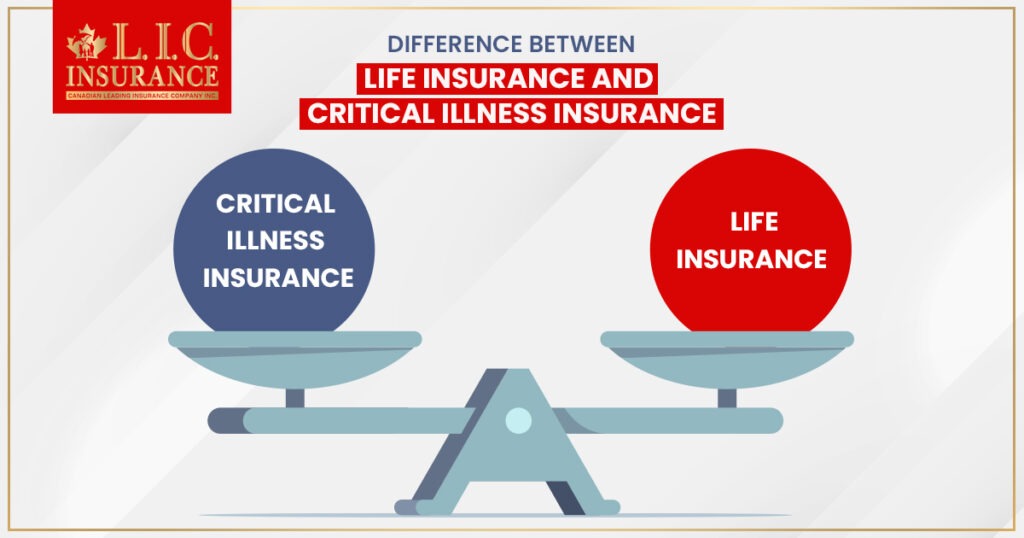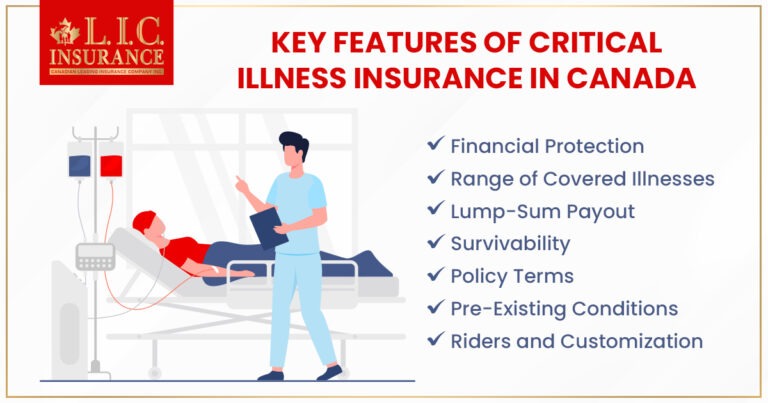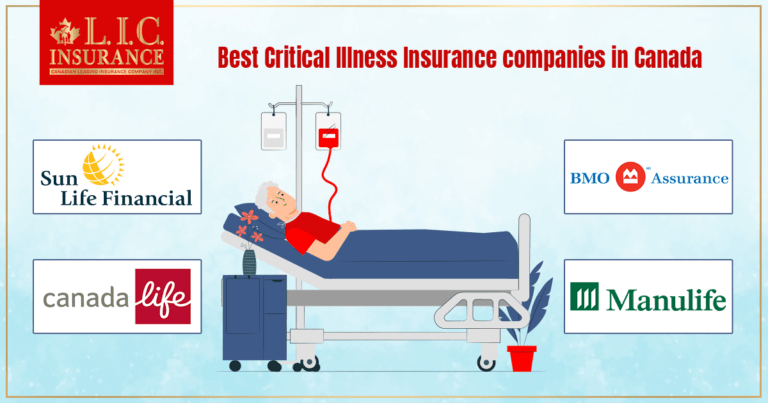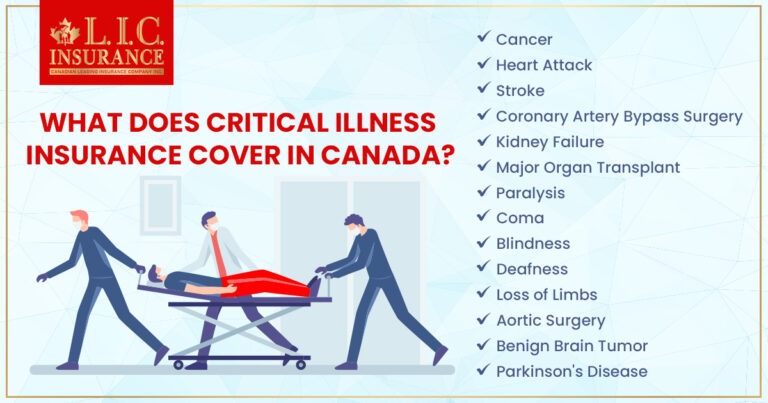- What Is The Difference Between Life Insurance And Critical Illness Insurance?
- Key Features Of Critical Illness Insurance In Canada
- Difference Between Life Insurance And Critical Illness Insurance
- What Does Critical Illness Insurance Cover In Canada?
- What Does Critical Illness Insurance Not Cover In Canada?
- Why Pairing Life Insurance with Critical Illness Coverage Offers Smarter Financial Protection

Many Canadians researching what is Critical Illness Insurance often overlook how it fits into a larger financial safety net. Understanding what is Critical Heath Insurance in combination with life coverage helps you plan beyond the basics. Critical Illness Insurance is a vital component of financial planning in Canada, providing individuals and families with crucial protection against the financial hardships that often accompany a serious illness diagnosis. This insurance product offers financial security by providing a lump-sum payout upon the diagnosis of a covered critical illness or medical condition. In Canada, where access to healthcare is mainly universal, Critical Illness Insurance fills the gap by addressing the financial aspects of dealing with a severe health crisis.
Key Features of Critical Illness Insurance in Canada

- Financial Protection: A critical illness diagnosis can lead to substantial medical bills, loss of income, and additional expenses, such as home modifications or caregiving costs. Critical Illness Insurance helps policyholders and their families maintain financial stability during these challenging times.
- Variety of Illnesses Included: Canadian Critical Illness Insurance often provides coverage for a variety of illnesses such as cancer, heart attack, stroke, and organ transplants. Individual policies and insurers may vary in which conditions they cover, so it’s important to read the fine print.
- Tax-Free Lump Sum: Lump-sum one-time payment to the policyholder when they are diagnosed with a covered condition. The fund can be used at their discretion, for whatever medical treatment, to pay down debt, to be able to live life while ill. The living benefit: Unlike a Life Insurance Policy, which pays out to the beneficiaries only after the insured person is dead, Critical Illness Insurance pays out to the policyholder while he or she is still living and struggling to survive. Even if the insured survives the illness, he/she get the sum assured.
- Policy duration: The duration of coverage of cancer insurance policies in Canada can differ. Certain policies may be term policies, and others may be permanent Life Insurance Policies. Choose a term that matches your needs and financial aspirations as a policyholder.
- Pre-Existing Conditions: When applying for Critical Illness Insurance, applicants are typically required to disclose their medical history. Some policies may exclude pre-existing conditions from coverage, while others may offer coverage with certain conditions or at higher premiums.
- Tax Benefits: Critical Illness Insurance payouts are generally tax-free in Canada, offering policyholders further financial relief during a health crisis.
- Riders and Customization: Some insurance providers offer riders that can be added to critical illness policies for additional coverage or benefits. This allows individuals to tailor their policies to meet their unique needs.
- Consultation and Advice: Given the complexity of insurance policies and the importance of making informed decisions, consulting with a licensed insurance advisor in Canada is advisable. One of the best financial advisors, like Canadian LIC, can help individuals assess their specific needs, compare policies, and select the most suitable coverage.
Which is why Critical Illness Insurance is a key component of Canadians’ financial security when illness strikes. Indeed, it provides peace of mind in the form of financial security at a moment when it’s most needed, as policyholders and their families would otherwise be left to worry about the financial stress accompanying such a difficult period. Like all insurance policies, you need to read that fine print, and if you’re not sure what it means (cause who really reads anything when it comes to insurance?), please contact a professional and get really good information before you make any decisions regarding Critical Illness Insurance in Canada. Check the Canadian LIC for the perfect answers according to your condition.
Read More – What is Critical Illness Insurance here
Difference between Life Insurance and Critical Illness Insurance
Life Insurance and Critical Illness Insurance are two distinct types of insurance products available in Canada, each serving a different purpose. The table given below highlights the key differences between Critical Illness Insurance and Life Insurance in Canada, including their purposes, triggering events, use of funds, premiums, taxation, and other important aspects.
| Aspect | Critical Illness Insurance | Life Insurance |
|---|---|---|
| Purpose | Provides a lump-sum payout upon the diagnosis of a covered critical illness or medical condition, providing financial support during recovery. | Provides a payout to beneficiaries upon the policyholder’s death, offering financial protection to loved ones. |
| Triggering Event | Payout triggered by the diagnosis of a covered critical illness during the policy term. | Payout is triggered by the policyholder’s death, as long as the policy is in force and premiums are up to date. |
| Use of Funds | The lump-sum payout can be used at the policyholder’s discretion, whether for medical expenses, debt repayment, or daily living expenses during illness. | Beneficiaries use the payout to cover immediate expenses, debts, and ongoing living expenses after the policyholder’s death. |
| Duration | Policies can be term-based or shorter-term, aligning with potential high-risk years for critical illnesses. | Term-based or permanent policies can last a lifetime, providing long-term protection. |
| Premiums | Premiums are generally higher due to the lower probability of a critical illness diagnosis during the policy term. | Premiums are typically lower because the likelihood of a death benefit payout is higher. |
| Beneficiaries | The policyholder receives the payout upon the diagnosis of a critical illness. | Beneficiaries receive the payout upon the policyholder’s death. |
| Customization | Riders can be added to enhance coverage, such as disability riders or return of premium riders. | Riders and endorsements are available to customize coverage, such as adding critical illness or accidental death riders. |
| Taxation | Payouts are typically tax-free, providing financial relief during a critical illness. | Payouts are generally tax-free for beneficiaries in Canada. |
| Pre-Existing Conditions | Coverage for pre-existing conditions varies by policy and insurer. Some may be excluded from coverage. | Policies may be issued without regard to pre-existing conditions, but coverage and premiums can be affected. |
| Waiting Period | Most policies have no waiting period, and coverage becomes effective immediately upon approval. | Coverage typically begins immediately upon policy approval or at the start of the chosen term. |
| Additional Benefits | May offer additional benefits, such as rehabilitation benefits or coverage for specific conditions unique to the policy. | May include riders for additional coverage, such as accidental death and dismemberment or living benefits. |
| Survival of Policyholder | Provides financial support to the policyholder while alive and dealing with a critical illness diagnosis. | Provides financial protection to beneficiaries after the policyholder’s death. |
| Common Covered Events | Covered conditions may include cancer, heart attack, stroke, organ transplant, and others. | Typically covers a broad range of causes of death, including illness, accidents, and natural causes. |
Purpose:
- Life Insurance: Life Insurance offers a financial payout to beneficiaries (typically family members or loved ones) if you die. It’s there to provide your family with financial support when you die, allowing them to pay bills like funeral costs, a mortgage, debts and living expenses.
- Critical Illness Insurance: Critical Illness Insurance Canada provides a lump-sum payment to you (the policyholder) if you are diagnosed with a covered critical illness or medical condition, such as cancer, heart attack, stroke, or other specified illnesses. The purpose is to help you cover medical expenses, treatment costs, and any additional expenses that may arise due to your illness, such as modifications to your home or loss of income during recovery.
Triggering Events:
- Life Insurance: The benefit is payable when the policy owner dies during the policy's term, and the policy remains in force and premiums are kept current. There is no payment if the policyholder is alive when the policy ends.
- Critical Illness Insurance: The benefit is payable upon the diagnosis of a covered critical illness or condition while the policy is in effect. If they survive the illness and live on, the full sum is given to the policyholder anyway.
Use of Funds:
- Life Insurance: Life Insurance proceeds will often be used to pay immediate bills, pay debts, and ensure that the survivors are financially healthy once their loved one has died.
- Critical Illness Insurance: Critical Illness Insurance Coverage Canada can pay out for whatever purpose you would like to, this can be treatment, care, paying off debts, lifestyle changes or anything else that applies to your participating critical illness.
Duration:
- Life Insurance: Policyholders buy Life Insurance for a certain period (term Life Insurance) or for the policyholder’s life(whole-Life Insurance), depending on the policy.
- Critical Illness Insurance: Critical Illness insurance can be acquired on a term basis, but they are usually a short-term policy. They are designed to offer protection in the years when you are likely to be more vulnerable to serious illness.
Premiums:
- Life Insurance: Life Insurance premiums are almost always lower than Critical Illness because there is more certainty in the case of Life Insurance (finally, everyone has to die).
- Critical Illness Insurance: Critical illness rates tend to be higher due to the chances of you getting diagnosed with a critical illness during the length of the policy.
It’s essential to weigh your financial needs and priorities when trying to determine which insurance you should buy. Life Insurance and then Critical Illness Insurance if that makes more sense for you. Some Canadians decide to purchase both Life Insurance and Critical Illness Insurance and have the best of both forms of coverage for themselves and their families here in Canada. By speaking with a licensed insurance professional, such as a Canadian LIC, you can be provided with the options available to you once you’ve completed each step.
Read More – Critical Illness Insurance here
What does Critical Illness Insurance cover in Canada?

Most Canadian Critical Illness Insurance policies have a specific list of critical illnesses and medical conditions they cover. The specific coverage amounts depend on the insurance company and policy, so it’s important to read the policy terms and definitions carefully. But here are common critical illnesses & diseases that are part of the Critical Illness Insurance policy in Canada:
- Cancer: Critical illness insurance generally covers different types of cance,r like breast cancer, lung cancer, prostate cancer, etc. Coverage might range from early stages up to advanced disease.
- Heart Attack: Generally covers a heart attack due to loss of blood flow to part of the heart muscle. The size of the heart attack can make a difference inthe payout.
- Stroke: Critical Illness Insurance usually includes both ischemic and hemorrhagic strokes, which can cause a blockage to blood flow to the brain or bleeding inside the brain.
- Coronary Artery Bypass Surgery: This may also provide cover for coronary artery bypass surgery, which is an operation that helps improve blood flow to the heart.
- Kidney Failure: End-stage renal failure (requiring regular dialysis or kidney transplants) is generally covered under critical illness plans.
- Major Organ Transplant: It will also cover the transplant of a major organ like the heart, lung, liver, or pancreas.
- Multiple Sclerosis: The diagnosis of multiple sclerosis, a chronic disease of the central nervous system, is covered by some policies.
- Paralysis: If policy allows, paralysis caused by a covered accident or illness, including something like a catastrophic spine injury, may be covered.
- Coma: A few plans cover coma due to a covered illness or accident with predetermined time periods and severity definitions for coma.
- Loss of Sight: The policy will commonly cover permanent and complete loss of sight.
- Hearing Loss: This benefit is usually for complete and permanent loss of hearing.
- Loss of limbs: The loss of limb or the use of limb due to an accident or illness could be included in the policy.
- Aortic Surgery: Some critical illness insurance policies do provide coverage for a psychotic episode.
- Benign Brain Tumor: The policy covers the diagnosis and surgery to remove benign brain tumours.
- Coverage for Parkinson's Disease: Parkinson's disease, a degenerative disorder of the nervous system, may be billed.
It’s worth noting that not all insurers or policies will cover the same list of illnesses and health conditions. Secondly, policies can have different definitions and parameters that determine the severity of a included illness and thus the amount of the payout.
Canadians should read and know the Critical Illness Insurance policy’s terms and definitions before they buy it. Call Canadian LIC- a licensed insurance advisor can help you choose a policy based on your particular health and financial circumstances.
What does Critical Illness Insurance not cover in Canada?

Canadian Critical Illness Insurance policies will have certain exclusions and limitations as well. These restrictions may differ by insurance company and the exact policy you select. Although the specific exclusions will vary, there are specific situations and instances that Critical Illness Insurance generally won’t cover:
- Non-Covered Illnesses: Critical Illness Policies cover only certain specified diseases and medical conditions stated in the policy. Any sickness or health condition not mentioned in the policy is not covered.
- Pre-Existing Conditions: Most policies have pre-existing condition exclusions. If you have a medical condition that you were diagnosed with before you bought the policy, that condition might not be covered. But some policies may cover pre-existing conditions after a waiting period.
- Self-Inflicted Injuries: Injuries that are self-inflicted or intentionally self-inflicted (i.e., injuries caused by suicide attempts) are generally not covered.
- Non-Diagnosed Conditions: In order to cash out, the critical illness must be diagnosed by a licensed physician in accordance with the policy’s guidelines. You can't just have symptoms and file a claim.
- Misrepresentation or Concealment: If you give incorrect information or you do not inform the insurance company of an important medical fact when you apply, the insurer could deny your claim.
- Alcohol or Drug Related: An individual who is critically ill due to the use of drugs or alcohol may not be covered. Also, an injury or illness caused by risky behavior when drunk or using drugs may also be a basis for exclusion.
- War and Terrorism: Sickness or injuries due to the effects of war or terrorism are usually excluded under Critical Illness Insurance.
- Active involvement in criminal activities: Personal lines companies that are turned over and will not be claimed upon due to the criminal involvement at the time of the critical illness, and you may have your claims denied.
- Failure to Follow Medical Advice: If you refuse to adhere to doctor-recommended treatments and advice for your condition, then the insurance company can reject your claim.
- Waiting Periods: Some plans have “waiting periods” before coverage is available. In this time, generally the first 3 months of the policy, you cannot make any claims.
- Specific Treatment Exclusions: Some treatments or conditions may be excluded. For instance, experimental or Health Canada unapproved treatments may not be covered.
- Age Limits: Certain policies carry age limits, i.e. coverage will only be provided to those under a certain age.
- Exclusions by Stages of the Disease: There are various stipulations, depending on the policy, for illnesses that are covered only at some stages of the disease. For instance, it might not cover all stages of cancer.
You need to understand if there are any exclusions or limitations which could surprise you at the time of a claim. If you have questions and want a quote, or if you wish to discuss the coverage in further detail, please don’t hesitate to contact Canadian LIC to determine your best fit!
Why Pairing Life Insurance with Critical Illness Coverage Offers Smarter Financial Protection
In Canada, families increasingly ask not just what is Critical Heath Insurance, but whether combining it with traditional Life Insurance is worthwhile. Many assume these are stand-alone products, but the growing trend of Life Insurance with critical illness riders offers a more holistic solution for modern financial planning.
When someone is diagnosed with a major illness, expenses don’t pause—mortgages, childcare, and utility bills still arrive. While Life Insurance supports your family after death, Critical Illness Insurance offers support during life’s most difficult moments, such as recovering from a stroke or undergoing cancer treatment.
Unlike what many competitors address, one overlooked benefit of bundling these coverages is accelerated underwriting. Some insurers in Canada streamline approvals when you apply for both simultaneously, reducing paperwork and offering better bundled premium rates.
Additionally, many Canadians don’t realize that some policies allow you to convert standalone Life Insurance into Life Insurance with critical illness coverage later, without a new medical exam, if your financial needs evolve.
So, when clients ask what is Critical Illness Insurance is or what Critical Heath Insurance, the answer should go beyond definitions. It’s about designing layered coverage that aligns with real-life risks—now and decades from now. This strategy ensures financial protection both during a crisis and after life ends.
Get The Best Insurance Quote From Canadian L.I.C
Call 1 844-542-4678 to speak to our advisors.

Faq's
Life Insurance is a product that will go to your beneficiaries when you die and give you a payout. In Canada, if you take out a Life Insurance Policy, you make regular premium payments and, in exchange, the beneficiaries you’ve chosen receive a single lump sum payment (the death benefit) when you die.
Critical Illness Insurance is a contract that pays the policyholder (you) a lump sum if you are diagnosed with an illness that is covered under the terms of the contract. That’s not the case with Life Insurance, which pays your beneficiaries when you die.
Critical Illness Insurance of Canada – Types of critical illnesses. The commonly defined critical illnesses in Canada with critical illness insurance could be cancer, heart attack, stroke, organ transplant, and other defined illnesses. Covered illnesses may vary from insurer to insurer, so it’s important to get to know the policy inside out.
Yes, lots of people have both Life Insurance and Critical Illness Cover for double protection! Life Insurance takes care of your family after your death, whereas critical illness insurance provides aid if you survive a critical illness.
That’s why Life Insurance premiums are typically much less expensive than Critical Illness Insurance in Canada, as Life Insurance has a higher probability of claim (since everyone dies). Critical Illness Insurance is more expensive because the chance of a critical illness happening is lower during the life of the policy.
Certain insurance companies in Canada have critical illness riders that can be attached to a Life Insurance Policy for an additional fee. You can have both of these types of coverage in one policy, making your insurance needs easier.
The right amount of coverage for you is based on your unique circumstances, including your financial obligations and goals, and your budget. It is a good idea to speak with a Canadian LIC such as Promax Insurance, which is an insurance expert who can work with you to determine what you need and how much coverage you should be.
Generally speaking, Life Insurance proceeds are not taxable in Canada. But tax implications for Critical Illness Insurance payouts are different and can depend on multiple scenarios, most of them on how the policy is set up. It is best to speak to a tax accountant in order to be fully aware of the tax consequences.
Yes, it’s possible to get approved for life or Critical Illness Insurance in Canada with a pre-existing health condition, but acceptance and terms of coverage may differ from provider to provider. It’s critical to disclose everything when applying for insurance, and some policies may have increased premiums or exclusions for pre-existing conditions.
Be ready to pick the provider and policy vehicle with the help of Canadian LIC, a licensed insurance advisor who can take you through a financial needs evaluation and provide you with choices so you get just the right policy that fits your financial goals and environment.
As always, you should read and understand the terms, conditions and exclusions of your policy before buying any insurance product in Canada.
The above information is only meant to be informative. It comes from Canadian LIC’s own opinions, which can change at any time. This material is not meant to be financial or legal advice, and it should not be interpreted as such. If someone decides to act on the information on this page, Canadian LIC is not responsible for what happens. Every attempt is made to provide accurate and up-to-date information on Canadian LIC. Some of the terms, conditions, limitations, exclusions, termination, and other parts of the policies mentioned above may not be included, which may be important to the policy choice. For full details, please refer to the actual policy documents. If there is any disagreement, the language in the actual policy documents will be used. All rights reserved.
Please let us know if there is anything that should be updated, removed, or corrected from this article. Send an email to [email protected] or [email protected]

